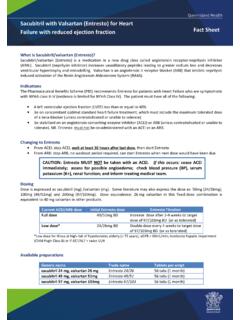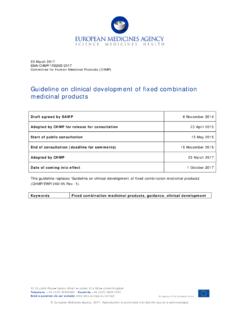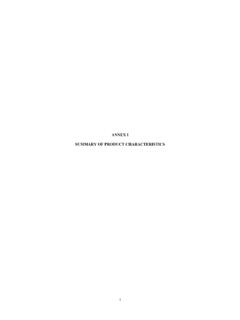Transcription of Assessing drug synergy in combination therapies
1 Assessing drug synergy in combination therapiesAdam Palmer, of Systems PharmacologyHarvard Medical SchoolOutlineIntroductionPharmacokinetic and pharmacodynamic drug interactionsDrug interactions depend on the phenotypeExperimental designFixed doses dose gradientsCheckerboardsAnalysis of drug interactionsDifferent null hypotheses:Pharmacological independence = Gaddum (1940)Pharmacological additivity= Loewe (1928) + Chou-Talalay (1984)Statistical independence= Bliss (1939)Experimental design revisitedClinical relevanceDemonstration of Isobologram analysisIntroduction - Why combination therapy?
2 Clinical Benefit Stronger pharmacologic effect Hinders evolution of drug resistancein viruses, bacteria, and cancers Clinical trials show superior outcomes for the right combinationssome drug combinations are both more effective and less toxicsome drug combinations are both less effective and more toxicResearch Use Combined perturbations reveal functional interactions between cellular processes drug interactions depend on mechanism of drug actionWhat do we mean by drug interactions ?
3 Pharmacokinetics = What the body does to the drugAbsorption, Distribution, Metabolism, Excretion (ADME)TimeConcentrationof drug Ain serumDrug AadministeredDrug AWhat do we mean by drug interactions ?Pharmacokinetics = What the body does to the drugAbsorption, Distribution, Metabolism, Excretion (ADME)In medicine and physiology, drug interaction means pharmacokinetic kinetics of drug Aare changed in the presence of another drug drug Ain serumDrug A andDrug BadministeredDrug ADrug BWhat do we mean by drug interactions ?
4 Pharmacodynamics = What the drug does to the body(or cell) dose administeredResponseto drugtreatment+ResponseDrug TargetTo molecular biologists, drug interaction usually refers to pharmacodynamicinteraction. Drugs in combination have unexpectedpotency, by dose response both drugs exert the same effect,Interpreting drug interactions is : drug interactions can vary by endpointDrug treatments usually affect more than one combination therapy could have:Stronger effect on phenotype #1 Weaker effect on phenotype #2 drug interactions must be understood in context of the.
5 In skin cancers with BRAF mutation, combination of BRAF + MEK inhibition has- More tumor inhibition- Less skin toxicityTo a toxicologist, drug synergy is bad because it refers to harmful effects(alcohol + barbiturates)Experimental Design[ drug A][ drug B]Experimental DesignSingle dosesLeast effortDose gradientsEfficientCheckerboardComprehens ive[ drug A][ drug B][ drug A][ drug B][ drug A][ drug B]Experimental DesignCheckerboardComprehensive[ drug A][ drug B]Practical for pairs insightful data:Reveals drug interactionsat all ratios between drugsExperimental DesignDose gradientsEfficient[ drug A][ drug B] fixed ratio combination [A] : [B] = 1 : 5 Mixed in equal potency= Equipotent (on a chosen readout)More effort than single- dose bya fixed factor (eg.)
6 8 more points)Easily scales to triple-, quadruple- drug combinations Need to chose a ratio between drugs (angle)Analysis can be attentive todose-response function Robust assessment ofinteractions at the chosen ratioDepends onchoice ofdrug ratio(angle)Experimental DesignDose gradientsEfficient[ drug A][ drug B] fixed ratio combination [A] : [B] = 1 : 1 Mixed in equal concentration= Equimolar More effort than single- dose bya fixed factor (eg. 8 more points)Easily scales to triple-, quadruple- drug combinations Need to chose a ratio between drugs (angle)Analysis can be attentive todose-response function Robust assessment ofinteractions at the chosen ratioDepends onchoice ofdrug ratio(angle)Might missinteractions ifpotencies DesignSingle dosesLeast effort[ drug A][ drug B]Depends onchoice of each drug seffectEasily scales to triple- , quadruple- drug combinationsHigh-throughput screeningData has limited value.
7 No analysis of dose -response prone to false-positiveinteractionsExperimental DesignCannot reliably detect a change in drug potency less than the increments in drug : Small-step serial dilutions400 Lmedia400 Lmedia400 Lmedia400 Lmedia400 Lmedia1200 L1000 nMdrug in mediaTransfer700 LTransfer700 LTransfer700 LTransfer700 LTransfer700 L Experimental DesignCannot reliably detect a change in drug potency less than the increments in drug : Small-step serial dilutions636 nMdrug405 nMdrug258 nMdrug164 nMdrug104 nMdrug1000 nMdrug in mediaAnalysis of drug interactionsIdentifying drug interactions depend on the no interaction are based on the observed drug responsenot a model of synergy means stronger than my mechanistic model predicts , then.
8 (1) a genuinely powerful combination isn t classed as synergistic if it is predictable(2) synergy /antagonism changes as your knowledge and model based on the dose -response are empirical,and do not depend on current state of well by Berenbaum (1989) What is synergy ?Pharmacological ReviewsAnalysis of drug interactionsIdentifying drug interactions depend on the no interaction are based on the observed drug responsenot a model of mechanismGaddum (1940): Pharmacological IndependenceAre two drugs more or less powerful than one drug ?
9 Loewe (1928): Pharmacological Additivity:Are drugs (A+B) more or less powerful than (A+ more A),or (B+ more B)?Also measured by the Chou-Talalay combination Index Bliss (1939): Statistical Independence of toxins:In a population, is each individual s probability of death from drug Astatistically independent of the probability of death from drug B?These are different alternative ways to ask the same (1940) Pharmacological independence[ drug A][ drug B] dose of drug Ahas a certain strength of much drug Ais needed to have the same effect when drug Bis added?
10 Gaddum (1940) Pharmacological independence No change No interaction[ drug A][ drug B] dose of drug Ahas a certain strength of much drug Ais needed to have the same effect when drug Bis added?+1 M drug BGaddum (1940) Pharmacological independence No change No interactionLess drug A is needed synergy [ drug A][ drug B] dose of drug Ahas a certain strength of much drug Ais needed to have the same effect when drug Bis added?+1 M drug BGaddum (1940) Pharmacological independence No change No interactionLess drug A is needed SynergyMore drug A is needed Antagonism[ drug A][ drug B] dose of drug Ahas a certain strength of much drug Ais needed to have the same effect when drug Bis added?




